The Power of Algorithms
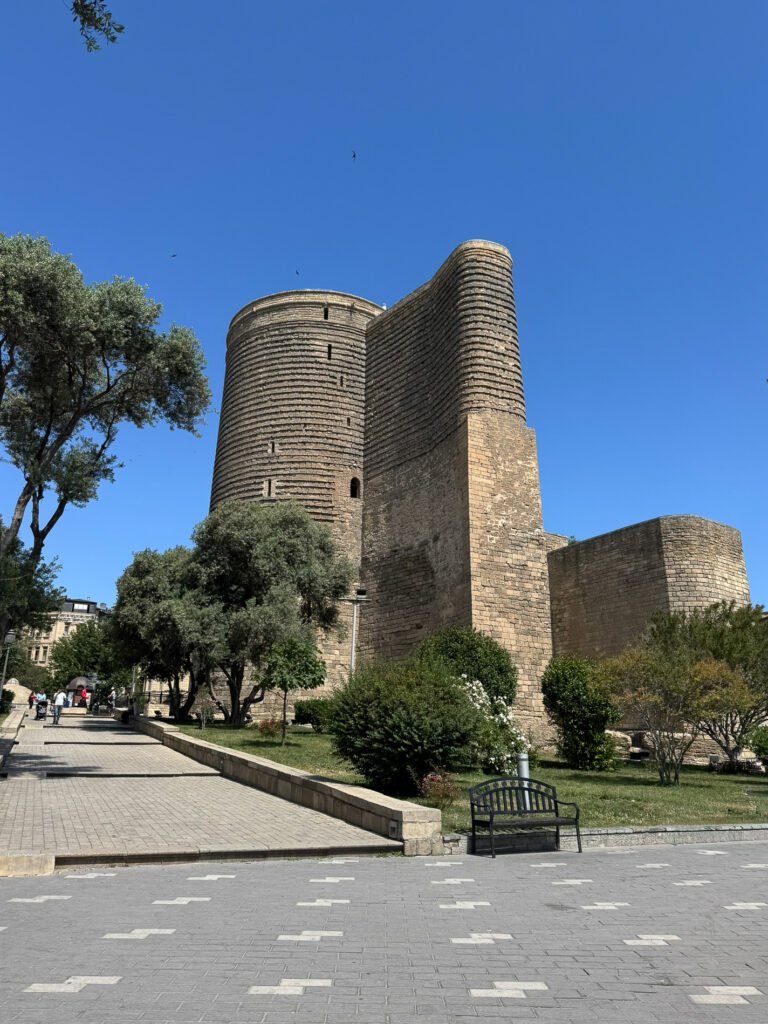
Sometimes I try to “educate” the wizard behind the Instagram algorithm. How? I hit “like” whenever I see something I want to see more of. Especially posts about faraway places in Asia, full of mystery and color.
One day, I saw a video, “this is not Paris…” showing unique architecture, it made me pause mid-scroll, “this is not Dubai,” showing a futuristic skyline… “This is Azerbaijan.” “Wow. Azerbaijan!?”. How the hell did I not know about this place?
Each post that followed was a confirmation: this was a place I wanted to see with my own eyes someday.
Keep that detail in mind — we’ll come back to it.
Spoiler: I Didn’t Go to Myanmar.
Still dreaming about photographing in Myanmar, I messaged K, Steve McCurry’s assistant in Asia, asking if he knew anyone who could guide me on a private trip there.
To my absolute delight, he replied: “I can!”
And that was it. We began discussing possible dates, and slowly the idea started taking shape. I messaged a friend I met in Vietnam, telling him about the plan. Without hesitation, he said he was in. Suddenly, there were three of us.
My departure date to Myanmar was set: May 1st.
But on the morning of March 28th, I opened WhatsApp and saw a message from K that made my heart stop:
“Just experienced the largest earthquake (in Bangkok) in the last 20+ years – wow! I am used to this kind of 3-4 Richter scale quote in Taiwan, but I think most local people must be scared to hell, especially in high-rise buildings (I am at 39F)”.
Later I found out the epicenter wasn’t even in Bangkok. It was in Myanmar…
Then came April 14th…
Exactly two weeks before we were supposed to fly. The message I had been dreading:
“Hi k, we (Mandalay) still suffering aftershocks. Mandalay airport is running only for local flights. I heard that government suspended tourist visas and allowed only business visas. The situation in Mandalay is worse than you think. Mahamuni pagoda´s building is collapsed and some of the buildings in marble street are cracked and collapsed. We can see collapsing buildings in every street. So, the current situation of Mandalay is not good to travel. And I don´t know which hotel in Mandalay is safe to stay because every hotel that I saw was cracked and collapsed. Thank you. “
And that was it.
We considered other options, but time wasn’t on our side. To make it worse, a six-day holiday was about to start in Brazil — so travel agencies, consulates, everything would be closed.
A decision had to be made…I let go of the Myanmar trip. At least for now.
First, I looked into South Korea — but prices were sky-high.
Then, like a lightbulb moment, I remembered those Instagram videos. The ones I had liked so many times without knowing they were leading me here.
Azerbaijan.
Mysterious. Surprising. Unexpected.
The destination I didn’t know I was dreaming of.
And just like that, a new adventure was born.
Baku – First Impressions
There I was — in Baku, the capital. It’s one of those times where you hear about a place for the first time, and a few months later, you’re actually there. I had this strange feeling – I had skipped over my months-long planning process I had refined over the last 10 years.
My hotel had the perfect location: right in the heart of the Old City, inside the ancient walls. One of the first things I asked Khanim, my guide, was whether it was safe to walk around by myself. She assured me it was completely safe so I went out to stroll / wander the city and the day couldn’t have been better: clear blue skies and a delightful temperature.
It’s one of my favorite travel moments — that first encounter with a new place when everything feels fresh, and every corner reveals a brand-new world. And what corners! Each one looked like the set of an old movie. Stone houses, fortress walls, cobblestone streets — all impeccably maintained.
The Walled City of Baku has been listed as a UNESCO World Heritage Site since 2000.
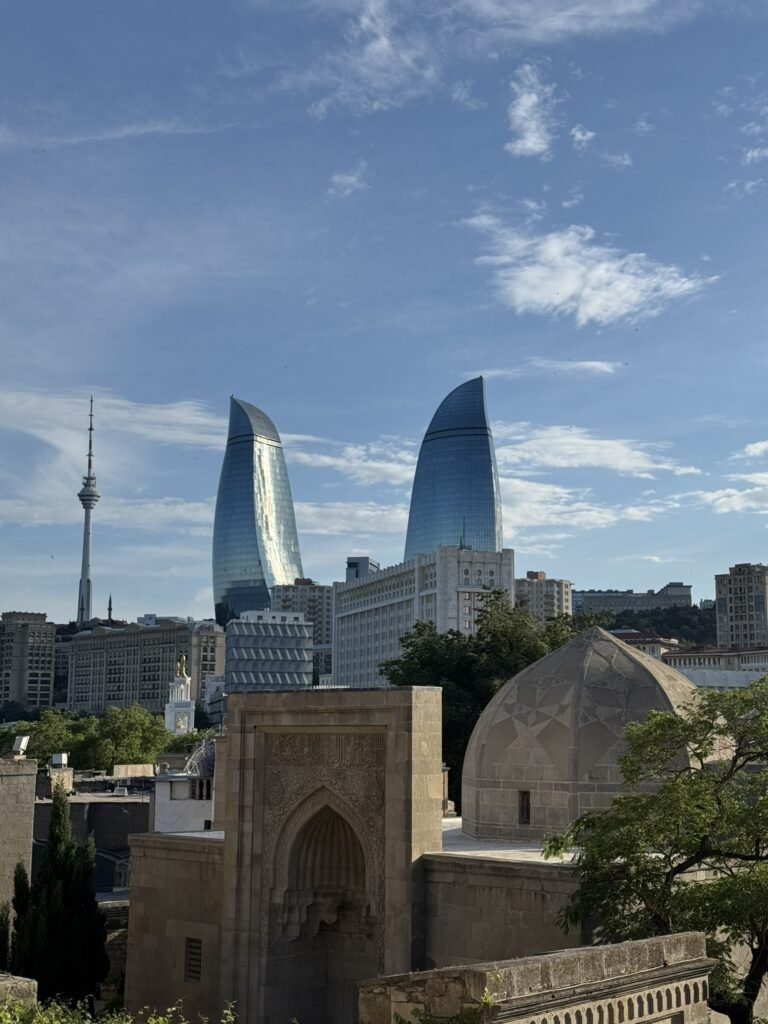
Since it was a Sunday, the place was lively — a mix of tourists and locals enjoying the shops, restaurants, and cafés. Some were visiting landmarks like the Maiden Tower, the Palace of the Shirvanshahs, and the mosques but today, I just wanted to wander — no itinerary, no destination, just the joy of walking.
After exploring the Old City, I left the walls and headed toward the Caspian Sea. A lovely boulevard stretches along the shoreline — perfect for walking, cycling, or simply watching life go by from one of the benches.
Somewhere along the way, I got a message from Khanim saying she’d be happy to join me for dinner if I wanted. Of course, I did! When the time came, I left the boulevard and walked to the restaurant she suggested, nearby the hotel.
I asked her to choose the dishes since it was my first real encounter with Azerbaijani cuisine. The beautiful thing about being someone who loves food — all kinds of food — is that you can happily say: “Order whatever you like from your country. I want to try it all.”
And after tasting everything… I can say: no regrets whatsoever!
The kebab was delicious, but what really won me over was my new favorite Azerbaijani dish: Qutab — a kind of pastry (thankfully not fried), usually filled with meat, fresh herbs, or cheese. Alongside came some salads, including one surprisingly simple and unique: tomato with cranberry sauce. I loved it.
The Downside? No Wine.
Some restaurants follow religious guidelines and don’t serve alcohol. And if you don’t already know how I feel about that, let me illustrate with a story about my mom:
She always loved going out for lunch or dinner — pairing food with the perfect drink. However, when she started needing more care due to Alzheimer’s, I was struggling to explain to her that she couldn’t drink anymore for medical reasons. So, at an appointment, I confirmed with the doctor again — in front of her — to reinforce it. She looked at him, furious, and said:
“What’s the point of eating out if I’m not going to drink?”
Right away, my brother turned to me, “Well… the apple doesn’t fall far from the tree, huh?”
Needless to say, this was the first and last time on this trip that I ate in a restaurant without wine.
A Sweet Surprise.
After dinner, Khanim suggested trying Azerbaijan’s famous baklava, made with layers of thin pastry, sweetened with syrup or honey and filled with walnuts, almonds, or pistachios. Honestly, I had given up on Middle Eastern desserts at that point — I had tried similar sweets in Morocco and Lebanon and always felt like they were just unnecessary sugar-bombs that covered up the delicacy of the pastry and nuts.
That’s perfectly fine with me since I’m already obsessed with the food. At least I can save some calories by skipping dessert… right?
Foolish me. Turns out, I loved the baklava too. It looks like the gym would have to work overtime after this trip.
Not bad for the first hours in Baku.
The Candy Cane Mountains – Instagram vs. Reality
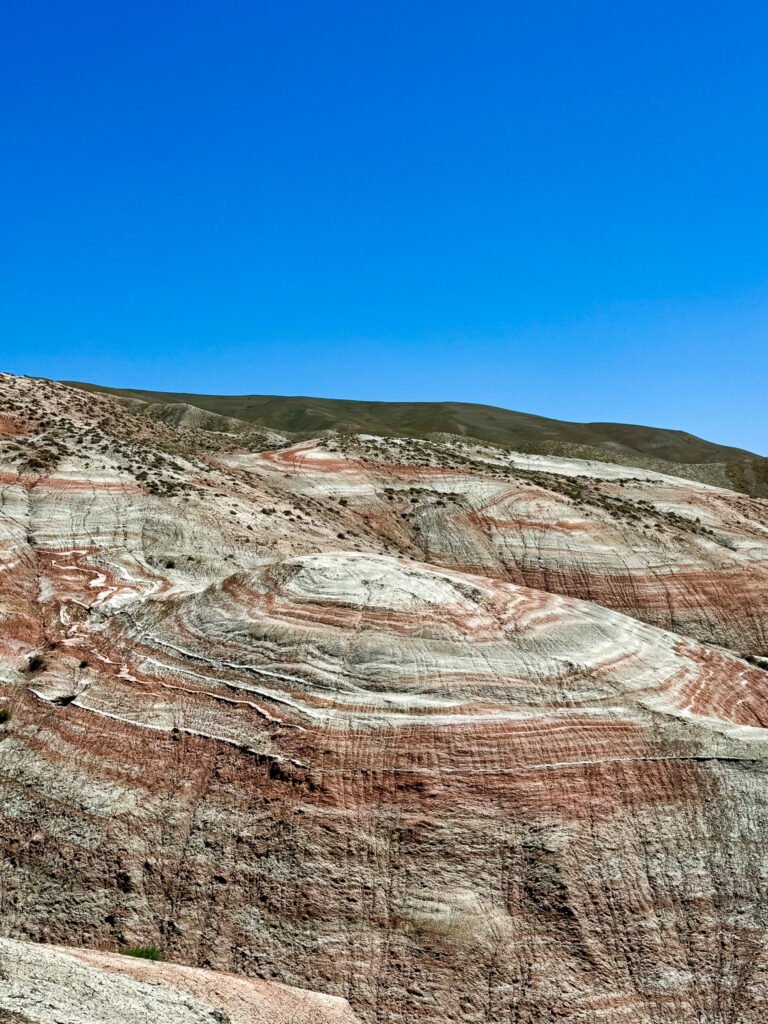
The next day´s plan was visiting the Candy Cane Mountains, and I had this weird mix of excitement and anxiety, not really knowing what to expect.
When I first saw this place on Instagram, my impression was clear: “This is the kind of place that looks absolutely stunning… from a drone or a helicopter, but from the ground? Not so much.”
I was so convinced of that, I didn’t even include it in my original itinerary.
But then, one week before my trip, I met a friend for lunch.
“Did you know Azerbaijan was featured on Globo Reporter last week?” she asked.
“What?!” — I answered. “I need to watch it. Like… now.”.
Back home, I immediately searched for the episode. And honestly? It got me even more excited about the trip. The show gave me a better idea of what I’d find in Azerbaijan — and it made the Candy Cane Mountains look like an absolute must-see, even on foot.
I sent a message to the travel agent asking if it was still possible to include the mountains in my trip. Not an easy task, as they took forever to answer, and the options they sent weren’t great. So, I boarded my flight not knowing whether this visit would happen or not.
Everything got solved once I met Khanim, who suggested we skip one of the museums — after all, we were visiting another very similar one — and use that time for the mountains instead.
Deal! And today was the day.
The moment we arrived, I had that sinking feeling that… maybe my first impression had been right all along.
I looked around and honestly struggled to find anything that matched the stunning views I had seen on TV and Instagram.
“Wait… is this really the same place?”
I started climbing — hoping to find the angle, the spot, the view that would at least remotely remind me of those photos and videos I’d seen.
And guess what? From the top… I finally saw it: the exact spot from the posts. But between me and that spot… was a deep valley. I’d have to trek down, climb up again AND ask someone to stay where I was to take photos of me from afar.
Basically… that’s how those Instagram shots are made. (along with loads of filters)
I looked back. Khanim was still far away, comfortably sitting in the car, checking her phone.
I felt too embarrassed to ask her to climb up here with me just to help with photos. But honestly? I wasn’t that impressed anyway. If I had really thought it was worth it, I would have asked her. I was underwhelmed by the mountain’s drab look compared to photos which had all been over-edited.
So… I did the only reasonable thing: took some photos from where I was and left.
In the end, I’m glad I went. Otherwise, I would’ve been stuck with that annoying feeling of “I was so close… and didn’t go.”
Sometimes it’s not about being blown away. It’s about checking that mental box and moving on — free from FOMO.
When Rocks Tell Stories – Discovering Gobustan’s Rock Art
Leaving the Candy Cane Mountains behind, we headed to Gobustan National Park to explore its famous prehistoric rock art.
At first, without knowing its importance in Azerbaijani history, Gobustan might just look like a jumble of giant boulders leaning against the mountainside. But once inside the park, your attention is drawn to the petroglyphs left behind by ancient inhabitants.
Carved into the rock were stories — scenes of everyday life from thousands of years ago: hunting parties, ritual dances, people sailing boats across now-vanished waters.
The site was created not only to protect these engravings, but also the mud volcanoes and musical stones found in the area. No wonder it’s part of the UNESCO World Heritage Sites — a place where nature and history blend, and even the rocks seem to whisper stories from long ago.
Mud Madness – The Wild Ride to Azerbaijan’s Volcanoes
Still, what truly caught my attention wasn’t just the mud volcanoes themselves — but the whole wild adventure it took to get there.
From the rock art site, we drove a short distance in our regular car until we reached what looked like a parking area. That’s where we had to switch vehicles — to an old Lada Niva. Yes, that’s right. The Russian car.
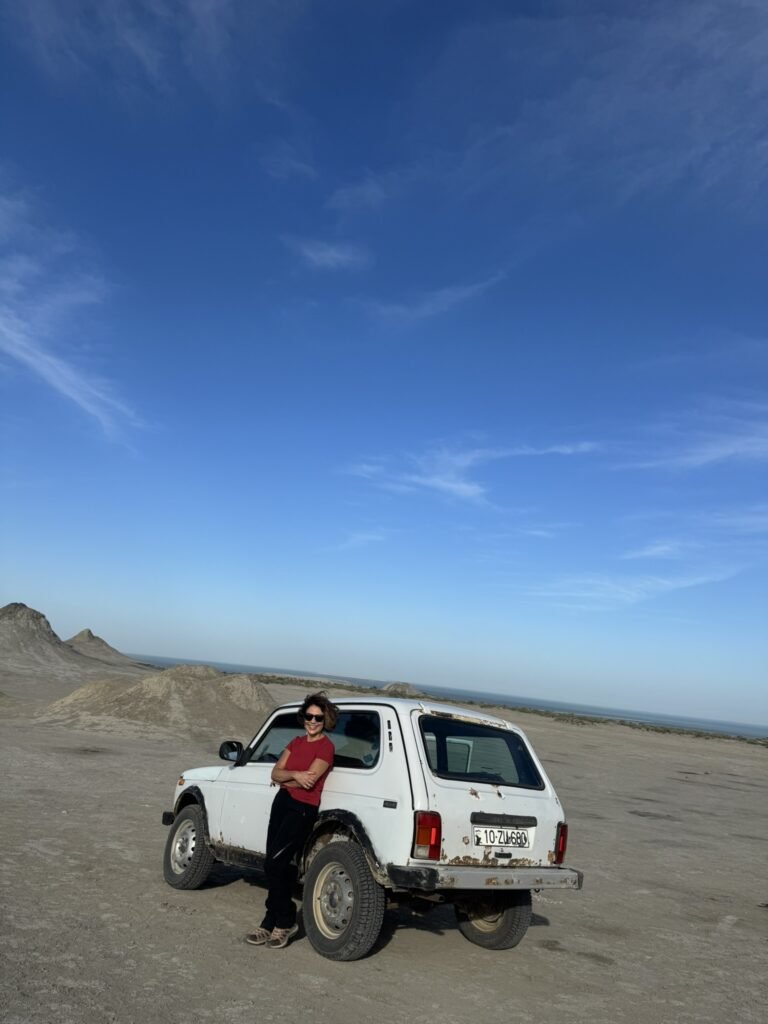
The moment we hit the road, it became obvious why the switch was necessary. The path was dusty, bumpy, and rough — the kind of road where only a sturdy, battle-tested car like a Niva could survive.
For a brief moment, my mind traveled back to the northeast of Brazil, a region famous for its beaches, dunes, and lagoons. One of the classic tourist experiences there is riding in buggies, where the driver always asks before starting:
“With or without emotion?”
It’s a polite way of asking if you want a calm ride or a crazy rollercoaster of jumps, sharp curves, and steep descents over the dunes.
Well… here? No one asked.
The “with emotion” option was simply assumed and suddenly, the old Niva was flying across the dirt road like a rocket.
We exchanged nervous glances, desperately searching for something — anything — to hold on to. A few sharp turns, potholes, and a terrifyingly steep hill later, we somehow made it to the top ALIVE. I swear — when the Niva reached the top of that slope, it actually took off and landed a few meters ahead like it was part of a stunt scene.
Sometimes I have this boyish side that loves a good adrenaline rush — as long as it doesn’t involve jumping from high places or hanging off the side of a mountain. So yes, I arrived there with my heart racing, absolutely thrilled… though it took me a minute to actually focus on the tiny mud volcanoes right in front of me.
These volcanoes are among Azerbaijan’s most unique geological wonders. Formed by underground gases and fluids pushing their way to the surface, they create bubbling cones of mud and rock. In fact, Azerbaijan holds the record for the largest concentration of mud volcanoes in the world — around 400 of them — including Toraghay, the biggest mud volcano on the planet.
The first thing anyone would assume is:
“That mud must be hot.”
Well… it’s not.
Of course, I had to check it out for myself. And, well… maybe not my brightest idea. Lucky for me, the driver came to my rescue with a big container of water he kept in the back of his car. Clearly, I wasn’t the first curious genius to try that.
After taking some photos and shooting a few videos, it was time to head back — the same bumpy ride, the same adrenaline, and honestly… I loved every second of it.
By the end of the day, I was exhausted — but filled with that priceless feeling of having created another unforgettable memory.
Baku by Night – A Gentle End to a Wild Day
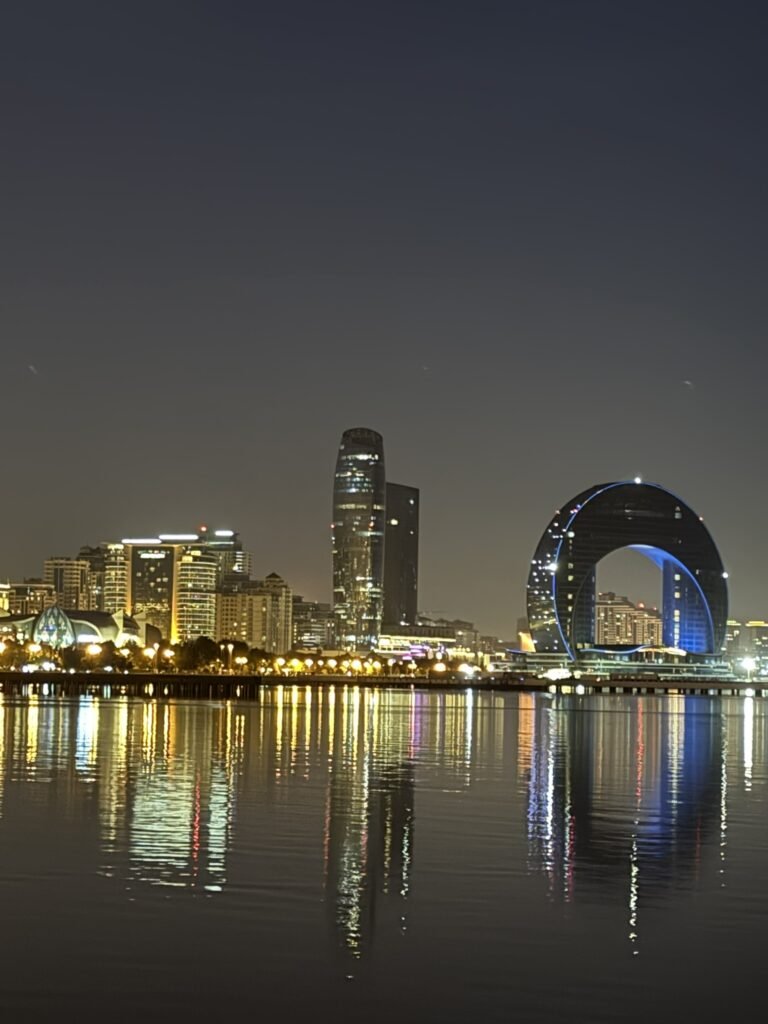
That evening, I decided to head back to the Boulevard, this time to check out the area where the famous Crescent is located and to see the Flame Towers lit up at night.
The feeling was the same as the day before — completely safe, even though it was Monday and already dark.
I admired both landmarks from a distance — the Crescent shimmering over the water, and the Flame Towers stealing the show as they shifted from the perfect image of flames to three men proudly carrying the Azerbaijani flag, and then to each tower glowing in one color of the flag.
I still wanted to get closer — maybe walk around the Crescent or find a better view of the towers — but honestly, my energy was running dangerously low.
So, I called it a day and walked back to the hotel — tired, content, and already dreaming of what the next day might hold.
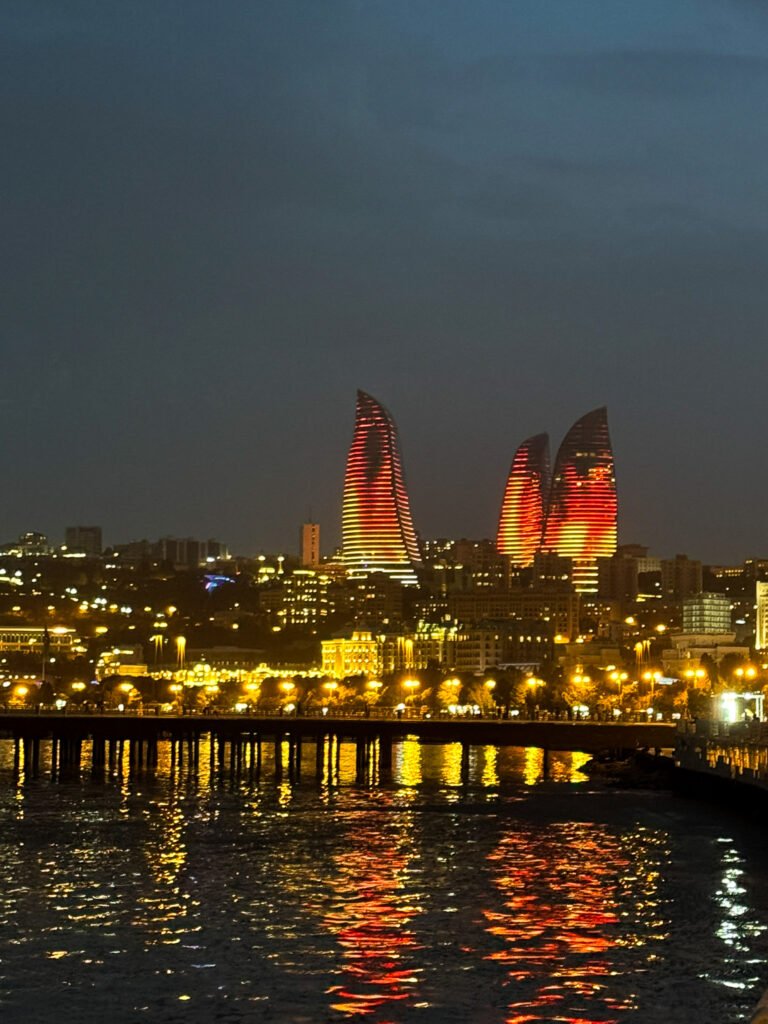
Fire in the Hills – Ancient Flames of Azerbaijan
What’s on the menu for today?
Road trip!
I’m crazy about road trips — whether I’m behind the wheel or just along for the ride. It makes no difference, as long as we’re rolling through unfamiliar places and my curiosity is wide open.
My first destination was Yanar Dag, the Fire Mountain, where flames have been burning for centuries, fueled by natural gas seeping up from underground.
This mountain holds deep cultural significance in Azerbaijan, a country known as the “Land of Fire.” The name is not just poetic — it reflects a legacy tied to natural flames like these and to Zoroastrianism, a religion that once worshiped fire as a sacred element.
It’s the kind of place that’s not just for geologists or history buffs — even a curious traveler like me couldn’t help but be fascinated to witness the eternal flames.
Built on Gas and Faith – Inside the Fire Temple
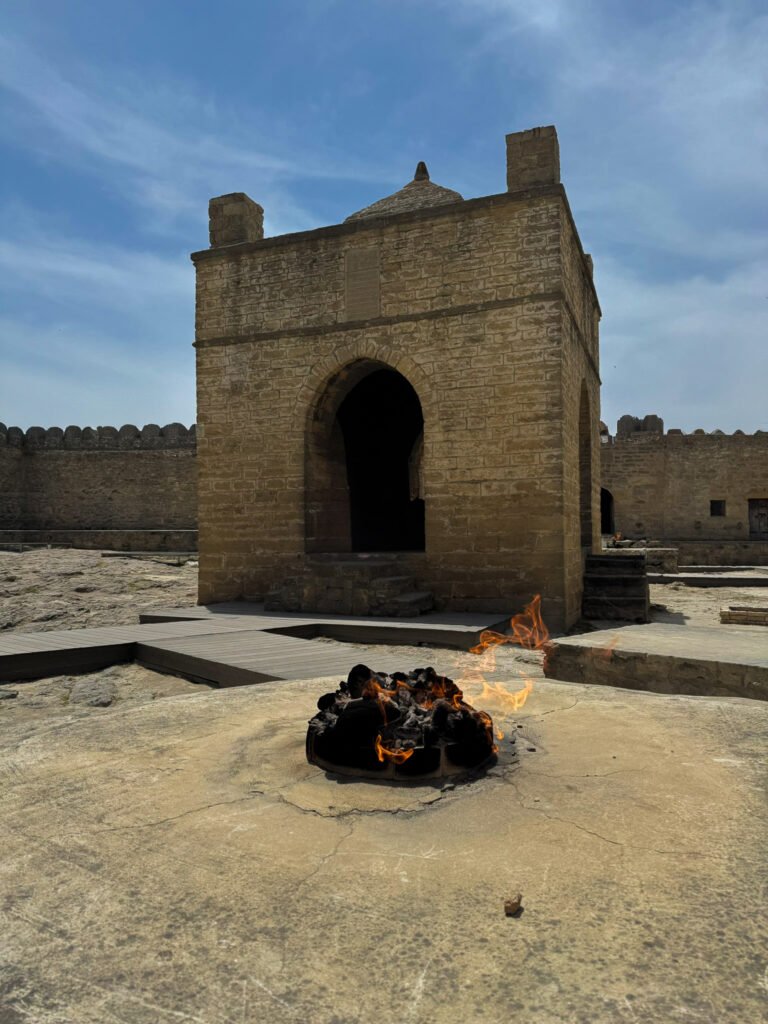
But our next stop? That was more my cup of tea:
The Fire Temple.
I’ll admit it — from the depths of my own ignorance — I knew nothing about Zoroastrianism before coming to Azerbaijan. Zero! So when I first read about this old temple, once used by Zoroastrians and later by Hindus and Sikhs, I honestly had no idea what to picture.
But then I saw photos — a simple yet striking stone structure: octagonal, with a fire altar at the center, surrounded by small chambers once used by monks and pilgrims. I searched my memory, looking for anything remotely similar that I might have seen before — and came up empty.
The temple was built atop a natural gas source, which once fueled the fires in the altar and surrounding area. Though once called an “eternal flame,” the gas dried up in the 19th century. Since then, the fires have been maintained artificially.
Today, the temple functions as a museum. But as I walked through it, I still saw people praying and paying their respects. The energy of the place remains — quiet, strong, and warm, just like the flame itself.
The Crescent at Dusk – Beauty, Scaffolding and Solitude.
Tonight, I decided to walk from the hotel to the Crescent area. It was about a 30-minute walk, and I wanted to see the building up close — and lit up at night. Besides, the path followed that pleasant boulevard along the Caspian shore, which already made the walk worthwhile.
I arrived just as night was falling. With the last traces of daylight still revealing some details, my first impression of the Crescent was… not quite what I expected. It instantly reminded me of a famous Brazilian song lyric: “Up close, no one is normal.”
It looked unfinished — empty and wrapped in scaffolding at the lower level. The area was partially closed off, with restricted access, clearly still under construction. I felt a bit misled. I had pictured it as a modern office space already in use, but there was absolutely nothing going on there.
Closer look: check.
Next mission: see it illuminated.
That would require some waiting — and after a day full of fire and dust, a good cup of coffee sounded like the perfect idea.
Once darkness finally settled, I focused only on the Crescent. And yes — it does look beautiful at night. You can feel its potential. It’s not quite there yet, but once it loses the construction-site feel and comes to life, I’m sure it will be truly impressive. It’s on its way.
On the walk back to my hotel, one thought kept returning: how incredible it is to feel safe. To walk alone at night, phone in hand, without a single worry — that’s priceless.
A Shrine in the Rocks – Visiting Diri Baba
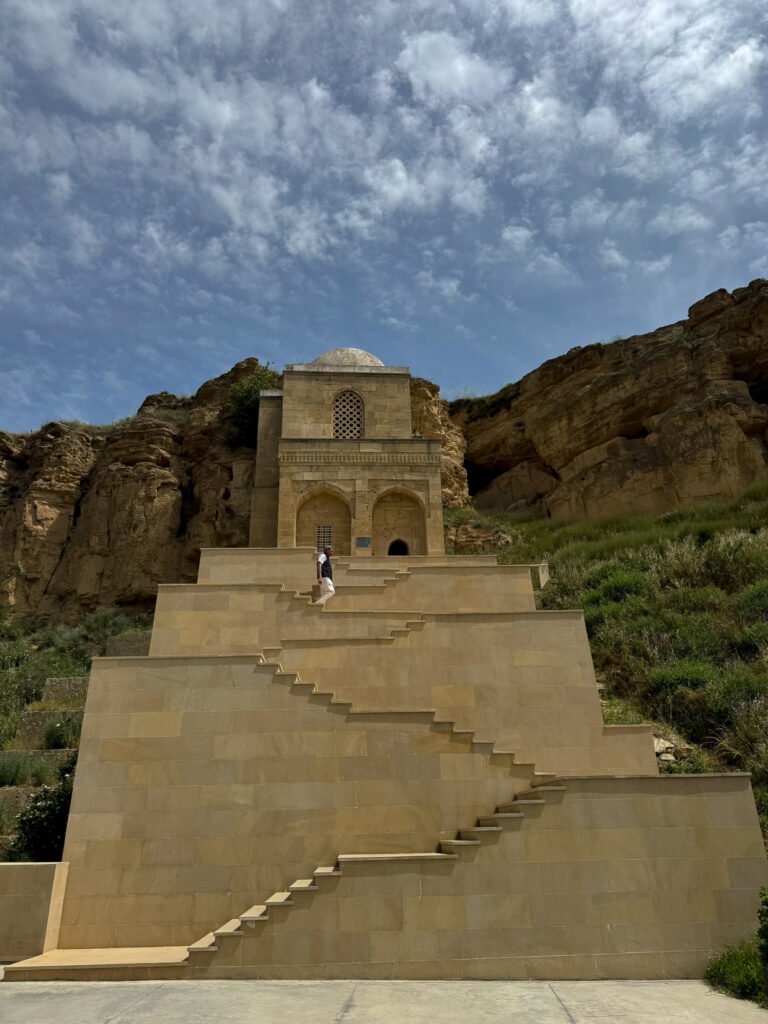
Another day of blue skies. Today, I’m leaving Baku behind — at least for a while.
Our first stop was the Diri Baba Mausoleum. Interestingly, the parking lot sits higher than the monument itself, offering a spectacular aerial view — a rare and rewarding perspective that immediately sets the tone.
Diri Baba is a mystical figure revered in Azerbaijan as a holy man or Sufi who lived in the 15th century. The name “Diri Baba” literally means “Living Father,” and it’s tied to the local belief that his body remains miraculously intact inside the mausoleum — even centuries after his death.
Many miracles have been attributed to him, and it’s said he reached a high level of spiritual enlightenment. That’s why the site has long been visited as a place of pilgrimage, both in the past and still today.
This fascinating 15th-century, two-story monument is quite literally embedded into the cliffside. Crowned with a spherical dome, it blends perfectly into the rock, as if the mountain itself had grown around it. The approach is marked by a stone staircase that immediately caught my eye — it reminded me of a modest version of Panna Meena ka Kund in Jaipur. Simpler, quieter, but with a similar hypnotic rhythm.
The architecture is minimal, yet powerful. And its location — at the center of a wide, open valley — adds an almost cinematic quality to the whole scene.
While I was there, I saw both pilgrims and curious travelers, like myself. It’s one of those places where spirituality and architecture coexist, silently enhancing each other. A place that speaks less through words and more through presence.
Beyond the Walls – The Unexpected Beauty of Sheki’s Summer Palace
The last stop of the day was the 18th-century Khan’s Summer Palace in Sheki. And honestly? It nearly fooled me.
When we arrived, there were a lot of people outside — but no actual line. Just a jumble of bodies trying to figure out where to go. To make things even more chaotic, there were entire busloads of students and teachers crowding the entrance.
From the outside, the palace didn’t really impress me. For a moment, I even thought about skipping it. But luckily, Khanim worked her magic, untangled the confusion, and soon we were inside.
And then — wow.
The walls were covered in magnificent frescoes and the most exquisite colored stained glass I’ve ever seen. There was no furniture, yet nothing felt missing.
The architecture was unlike anything I’d seen before — a mesmerizing mix of geometric glasswork, floral frescoes, and delicate arabesques. A style deeply rooted in the region, but completely new to my eyes.
I was absolutely stunned. And, of course, desperate to take photos — but photography wasn’t allowed.
It was even hard to focus — so many intricate details fighting for attention. My eyes and mind couldn’t settle on just one thing.
I’m so glad I didn’t give up.
Stone Walls, Silk Roads
Before heading to the hotel, we made a quick stop at Sheki’s Karvansaray.
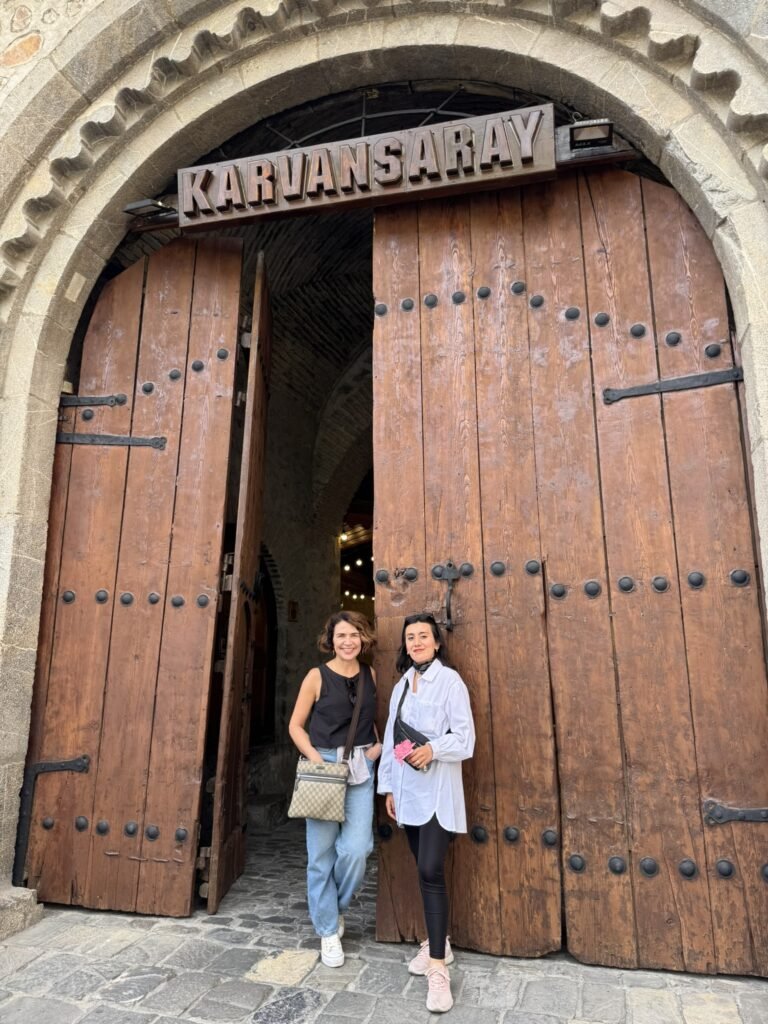
This impressive historic complex was originally built to shelter travelers and merchants journeying along the Silk Road — and incredibly, it still operates as a hotel today.
The building features a beautiful central courtyard, surrounded by stone archways and guest rooms. When we visited, the place was bustling with people — full of life and energy.
After such a full day, hopping from one incredible site to the next, I was completely exhausted — but also deeply grateful. Grateful for what I’d seen, what I’d learned, and what I was lucky enough to witness as a traveler.
Already looking forward to whatever tomorrow might bring.
One more palace, one more prayer hall, one more sore foot. Worth every step.
The First Christian Temple? Maybe. Beautiful? Definitely.
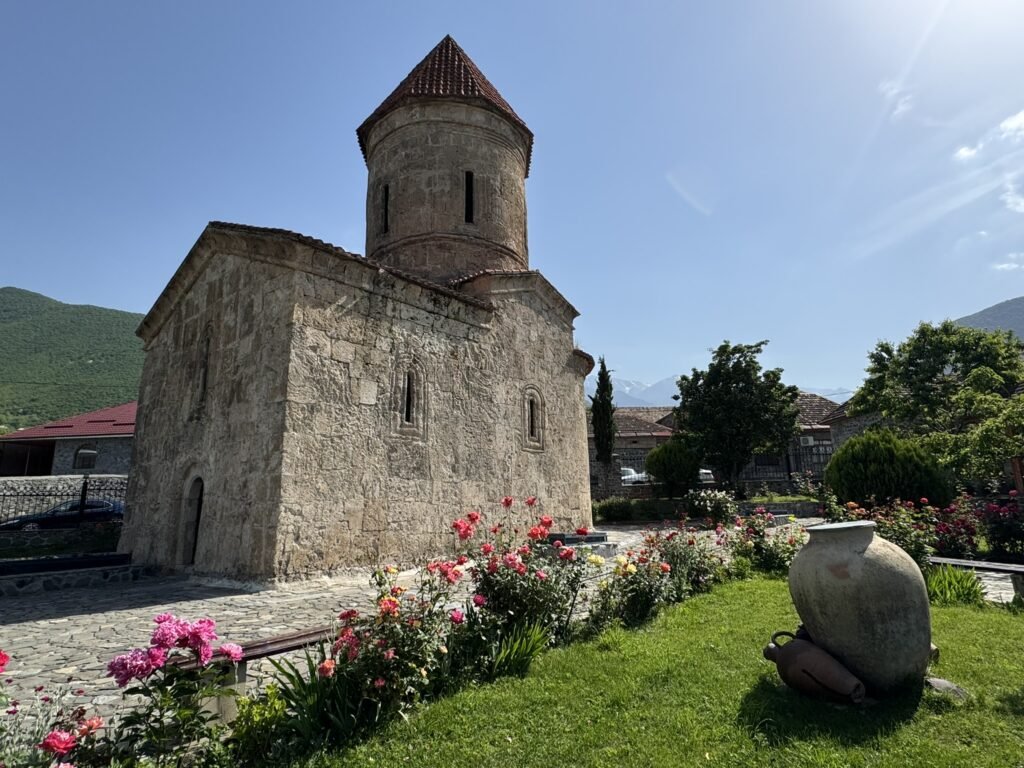
Leaving Sheki behind, we made our way to the nearby village of Kish, a popular destination thanks to its Albanian Church.
With its remarkable architecture and historical significance, the church is also surrounded by an intriguing belief: some say it was built in the 1st century AD, potentially making it the world’s first Christian temple.
Others argue it’s actually a 12th-century Georgian church.
These conflicting theories — and the mystery surrounding its true origin — only make the round-shaped, stone structure even more fascinating.
And that morning, I had it all to myself.
The peaceful setting gave me time to take in every angle — both outside and inside — and I left the place enchanted by its quiet beauty and timeless presence.
From the Heights of My Shallow Wine Knowledge
After visiting such a beautiful and historical place, I was more than excited to visit my first winery in Azerbaijan.
Yet another reason to love being on vacation: you can start your day with a wine tasting at 10 a.m., and no one says a thing. Excellent!
From the heights of my shallow wine knowledge – and having tasted only local wines for seven days (yes, I drank every day — all in the name of cultural immersion, of course), I could tell they’re on their way to producing some good stuff.
I particularly liked one made from Chardonnay grapes — fresh, elegant, and honestly better than I expected.
Another interesting thing was discovering grapes I had never even heard of before, like Madrasa and Bayanshira. I always love when travel introduces me to new flavors, especially when they come in a glass.
The winery itself was a great choice. The visit starts with their Wine Museum, which tells the story of the beverage and of the winery itself. It’s beautifully curated and impressively organized.
The staff was incredibly kind, and my visit ended — as it should — with the long-awaited tasting.
Fun fact: Sweet and semi-sweet wines are still quite popular here.
Unlike many other wine regions I’ve visited which are moving toward zero sugar, “nature” style wines — I actually prefer these myself. That was part of the reason the tasting didn’t quite impress me — two of the five wines were sweet or semi-sweet.
Like I said: they’re on their way. Not quite there yet.
Not Every City Is a Favorite — A Day in Ganja
Ganja wasn’t exactly a highlight.
The Goy Mosque was interesting, but didn’t stand out among others I had visited. A nearby Orthodox church left an even colder impression — especially with an elderly woman inside making it clear we weren’t welcome.
Our last stop was the so-called “Bottle House,” a quirky two-story building covered in glass bottles. The place itself didn’t do much for me…
But the man who welcomed us was so genuinely kind — proudly showing photos of celebrities who had visited — that the moment became oddly memorable.
It’s curious how one person can make an experience better or worse.
I had both in Ganja. I guess that’s how life works.
A Feast to Remember – Ending in Baku with Shah Plov and Old Walls
After a six-hour drive, we were back in the Old City.
In these final two days, I’d explore Baku’s medieval treasures within the walls — like the Ichari Shahar Fortress, the Shirvanshah Palace, the local market, and the unique Maiden’s Tower, dating back to the 12th century.
One of the things that fascinated me most about Baku — and Azerbaijan as a whole — was its seamless relationship between old and new. One moment, I’d be walking through centuries of history. The next, I’d be stepping into an ultra-modern wonder like the Heydar Aliyev Cultural Center. And somewhere in between, I’d suddenly find myself strolling down streets that looked like they belonged in Paris.
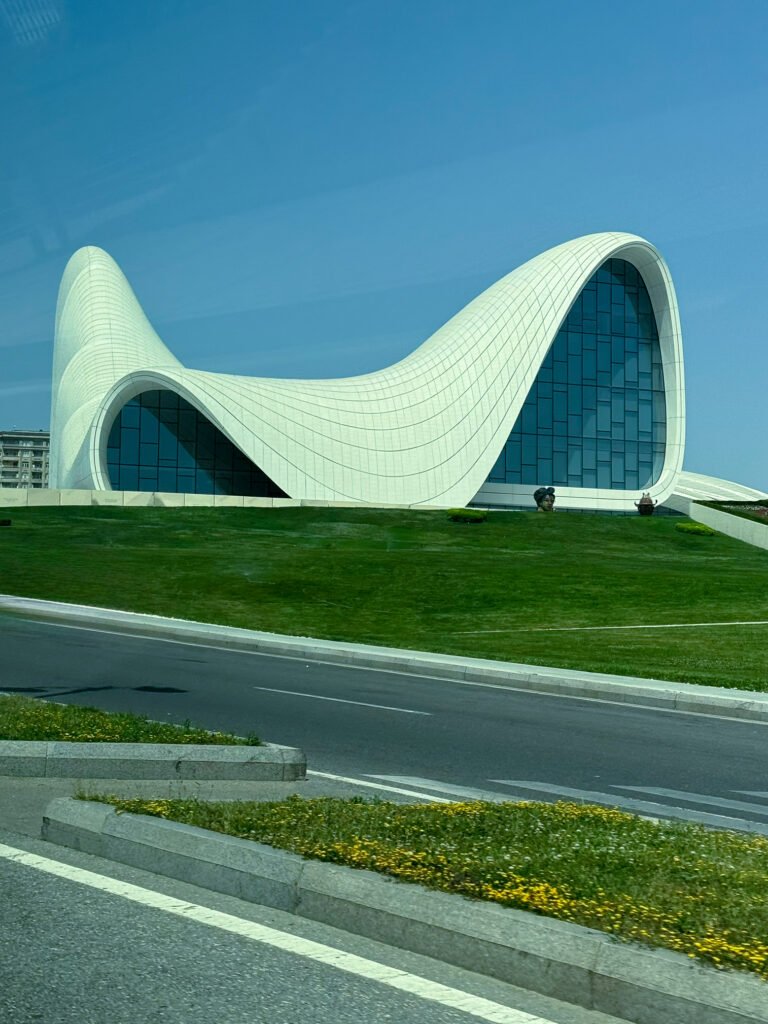
Before leaving the country, we had one last unforgettable Azerbaijani lunch.
At first glance, the restaurant didn’t promise much — just a small, simple entrance leading to a staircase and an underground dining room. But the moment I stepped inside, I knew it was a hidden gem.
Stone walls, traditional carpets hanging like art, soft lighting highlighting the beautiful arched ceilings — it was cozy, intimate, and full of character.
But of course, atmosphere means nothing without great food. And they had it.
The service was just as good — warm, attentive, and personal.
In a country where wine isn’t exactly a main attraction, you sometimes get red wine served too cold, and white or rosé not cold enough. So when I found a perfectly chilled Chardonnay, I was genuinely happy.
As I sipped my wine and nibbled on some delicious Qutab, I noticed a waiter placing a massive, stunning dish on the nearby counter. I’d never seen anything like it — and then he lit a candle beside the tray, making the entire thing look even more theatrical.
I turned to Khanim and asked, “What is that?”
She answered casually, “Our lunch.”
I was in awe. My jaw dropped, my eyes sparkled. She laughed at my reaction.
When the dish finally arrived at our table, I was still recovering. The waiter took a knife and sliced it open. The crispy golden crust gave way to a burst of fragrant yellow rice, nuts, and tender lamb.
The name? Shah Plov.
And it became my favorite Azerbaijani dish — a perfect balance of textures and flavors, wrapped in a crunchy layer of baked lavash.
A royal dish to end a royal trip.
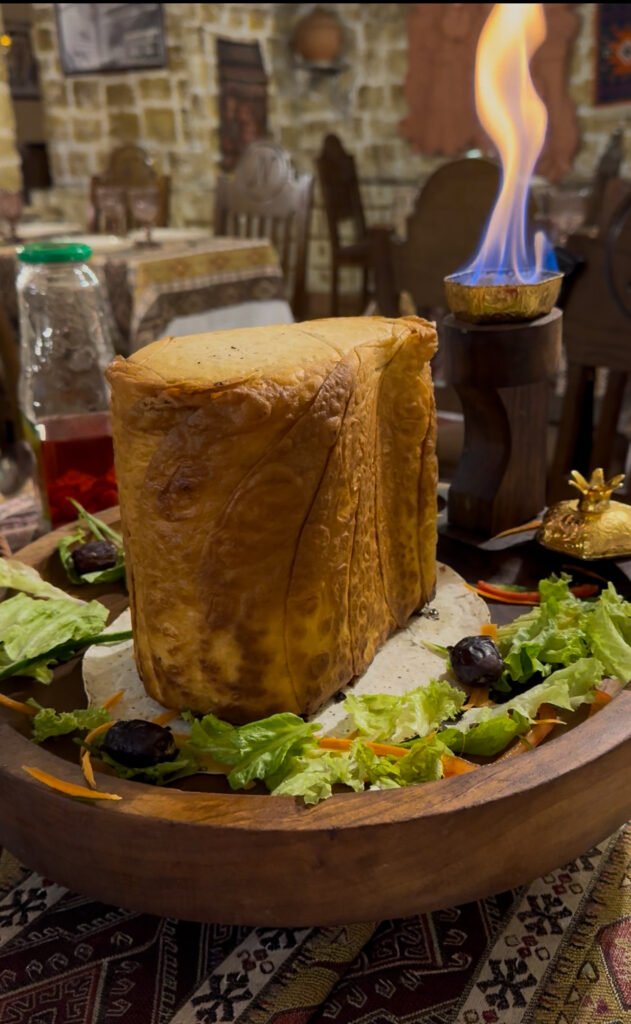
And next time? I might just start with Plan B
The week flew by like a high-speed train.
As I browsed for souvenirs, I could hardly believe it was already time to leave.
I was going home with a heart full of sweet memories.
The contrast between old and new, the sense of safety, the food, the people — everything had left a lasting impression.
And to think… this was a Plan B trip.
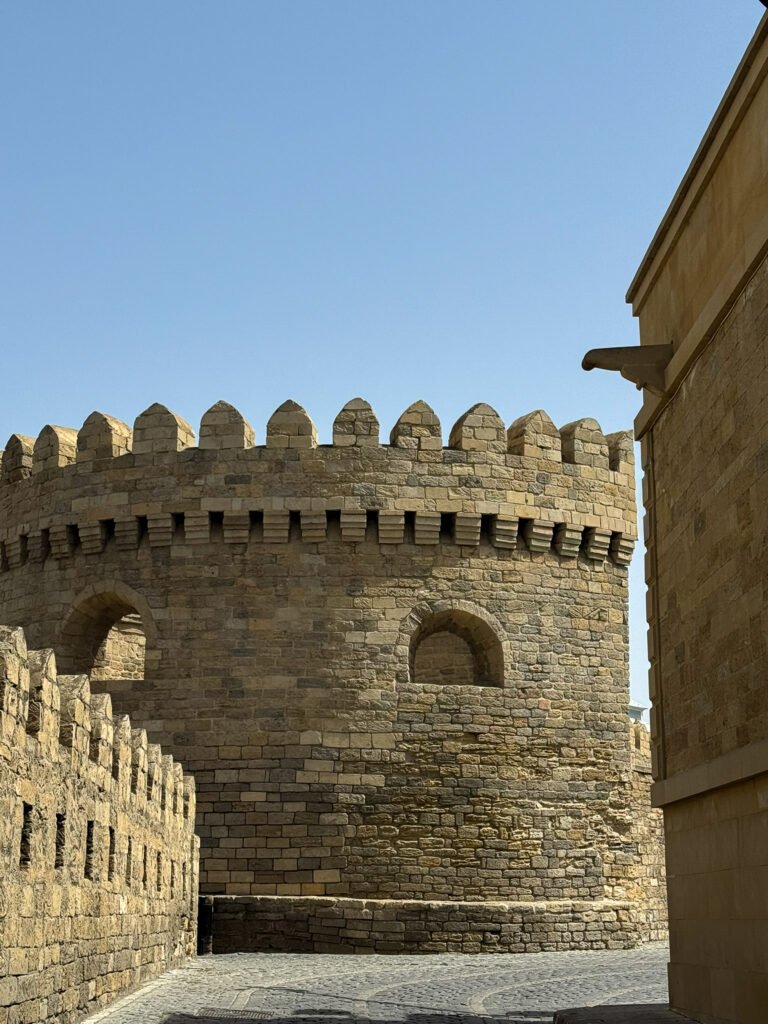
Uau!!!
Amazing trips, amazing stories…
Tell me more 🩷
Such a great experience and all I keep thinking about is the Shah Plov 😬
So do I….
😂😂😂😂😂
I recently met a journalist lady from Azerbaijan and had some nice moments taking pictures of her in Bangkok! She is one of the rare Christian in Azerbaijan, Baku is her hometown, although she studied and lived in St. Petersburg before moving to Bangkok a couple of years ago. An Azerbaijani trip is on my calendar.
What a small world! Baku truly left a mark on me — such a fascinating mix of cultures and stories. I’m sure you’ll have an amazing time there!